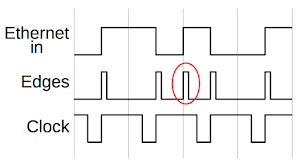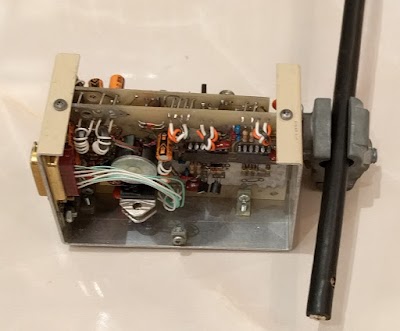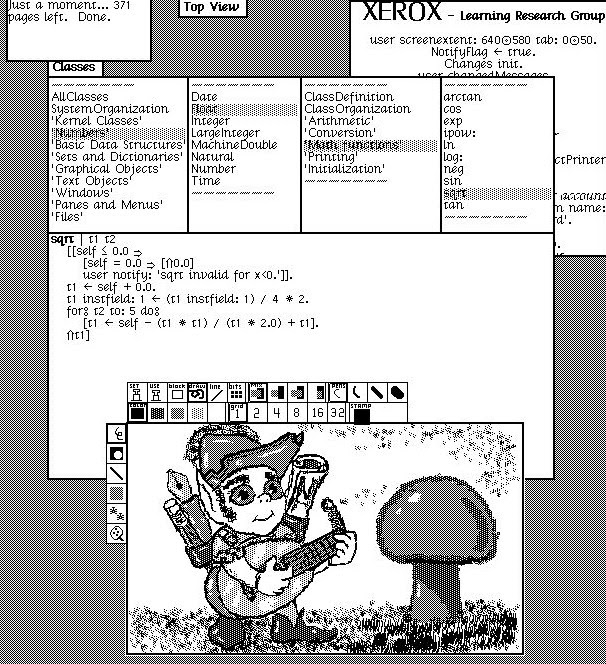A Xerox Alto system on the East coast had Ethernet problems, so the owner sent me the Ethernet board to diagnose. (After restoring our Alto, we've heard from a couple other Alto owners and try to help them out.) This blog post describes how I repaired the board and explains a bit about how the Alto's groundbreaking Ethernet worked.
The Alto was a revolutionary computer designed at Xerox PARC in 1973, introducing the GUI, high-resolution bitmapped displays and laser printers to the world. But one of its most important contributions was Ethernet, the local area network that is still heavily used today. While modern Ethernets handle up to 100 gigabits per second, the Alto's Ethernet was much slower, just 3 megabits per second over coaxial cable. Even so, the Alto used the Ethernet for file servers, email, network boot, distributed games and even voice over Ethernet.
The Alto's chassis slides out of the cabinet, allowing access to the circuit boards (see above). To test the Ethernet board, I plugged it into the Alto we've restored. The Ethernet board is hanging out the right side of the chassis because I used an extender board.
The board had a couple straightforward problems—a chip with a bent pin (which I straightened) and another chip with broken pins. (While some people recommend re-seating chips on old boards, this can create new problems.) The broken chip was a 74S86, a quadruple XOR gate that has been obsolete for years (if not decades). I replaced it with a 74LS86, a similar but non-obsolete chip.1
When I powered up the Alto, I didn't get anything from the Ethernet board: it was not sending or receiving successfully. This double failure was a bit surprising since malfunctions usually affect just one direction. But I quickly discovered a trivial problem: when I pulled out the Alto's cabinet to access the circuit boards, the Ethernet connector on the back came loose. After plugging the connector in, I saw that the Alto was sending packets successfully, but still wasn't receiving anything.
I started probing the Ethernet board's input circuit with the oscilloscope. The board was receiving the input okay, but a few gates later the signals looked kind of sketchy, as you can see above. The yellow trace is the input Ethernet signal. The board applies an R-C filter (green) and then the signal edges are detected (blue). While the input (yellow) is a clean signal, the green signals only go up to about 2 volts, not the expected 4-5 volts. Even worse, the blue waveform is irregular and has "runt" pulses—short irregular signals that don't go all the way up. With waveforms like this, the board wouldn't be able to process the input.
Manchester encoding and the decoding circuit
I'll take a detour to explain the Ethernet's Manchester encoding, before getting into the details of the circuitry.
The Alto's Ethernet encoded data over the coaxial cable using Manchester encoding.32 In this encoding, a 1 bit is sent as a 1 followed by a 0, while a 0 bit is sent as a 0 followed by a 1. The diagram below shows how the bits "0110" would be encoded. A key reason to use this encoding is that simplifies timing on the receiver, since it is self-clocking. Note that there is a transition in the middle of each cell that can be used as a clock. (The obvious scheme of just sending the bits directly has the problem that in a long string of 0's, it's hard to know exactly how many were transmitted.)
To decode the Ethernet signal arriving at the Alto, the first step is to extract the clock signal that indicates the timing of the bits. To extract the clock, the transitions in the middle of each bit cell must be detected. The trick is to ignore transitions at the edges of cells. The diagram below shows how the clock is extracted. First, edge pulses are generated for each transition edge of the input. Then, a clock pulse is generated for each edge pulse. The clock pulse about 75% of the width of the bit cell, and any second pulse that happens while the clock is still high is blocked. (The edge circled in red is an example of an ignored edge.) The result is the steady clock signal, synchronized to the input.4 This clock is used to latch the input signal value into a shift register, which converts the serial Ethernet stream into a word value usable by the Alto.
The schematic5 below shows the circuit that performs this clock extraction. There are a few tricks in this interesting semi-analog circuit. When the Ethernet input signal changes, the low-pass R-C (resistor capacitor) filter output will be slower to change. This will cause the edge detect XOR gate to go high briefly until the R-C signal catches up. Then the clock is generated by a "one-shot", a chip that generates a fixed-width pulse for each input pulse. The pulse width is set to about 75% of the bit cell width by another resistor and capacitor. The one-shot is wired to ignore any additional pulses that occur while the clock output is high.
Since the timing in this circuit was controlled by multiple resistors and capacitors, I thought that a capacitor might have gone out of tolerance. But first I decided to do the simpler test of swapping the XOR chip with the one from our working Alto board. Surprisingly, this fixed the problem, and the Ethernet board now functioned flawlessly. Thus, while the 74LS86 has input characteristics similar to the 74S86, they weren't close enough, and substituting the more modern chip messed up the R-C filter's behavior. (If the gate draws too much input current, the capacitor won't charge as fast.) Marc dug through his collection of old chips and found another 74S86 so we could get both boards operating.
The oscilloscope trace above shows the nice, steady clock (pink) after replacing the XOR chip. With the right XOR chip, the RC-filtered signal (green) rises to 4 volts, unlike before when it just went to 2 volts. The edge signal (yellow) is nice and even, without the "runt pulses" seen earlier.
An overview of the Ethernet board
I'll wrap up by explaining a bit about the Alto's Ethernet board (shown in the photo below). The large connector at the left plugs into the Alto's backplane, providing communication with the rest of the system. The small connector at the right connects to the Ethernet, via a transceiver. Some of the key components of the Ethernet interface are labeled on the diagram below. With this generation of chips, even a whole board of chips doesn't give you a lot of functionality so much of the Ethernet functionality is implemented in software and microcode.
Most of the chips are simple TTL logic, but the board uses a few interesting and obscure chips. Input and output data goes through a 16-word FIFO buffer built from four Intel 3101A RAM chips; each one holds just 16×4 bits. (The 3101 was Intel's first product.) Commands to the Ethernet board are decoded by three Intel 3205 decoder chips. Buffer chips interface between the card and the Alto's bus. Shift registers for the input and output convert between data words and serial data over the Ethernet. The CRC error checking is done by a specialized Fairchild 9401 CRC chip. Surprisingly, the Manchester encoding is implemented with a PROM-driven state machine, built from two Intel 3601 PROMs. Finally, the XOR chip is the chip that caused all the problems.5
The board has TTL inputs and outputs, so it doesn't connect directly to the Ethernet cable. Instead, a transceiver box is the interface between the Alto and the cable. In the photo below, you can see the transceiver clamped onto the coaxial cable. The transceiver converts the Alto's logic signals to the signals on the cable and injects the signals through an isolation transformer. In addition, the transceiver detects collisions if the Alto tries to send at the same time as another machine on the network.
You might wonder how the Alto can communicate with a modern system, since the Alto's 3 Mb/s Ethernet isn't compatible with modern Ethernet. I am building a gateway based on the BeagleBone (below) that uses the BeagleBone's microcontroller (the PRU) to "bit bang" the Ethernet signals. The BeagleBone also runs an implementation of IFS (Interim File System), the server side software to support the Alto. This is a C# implementation of IFS written by the Living Computers Museum.
Conclusion
Bob Metcalfe invented Ethernet at Xerox PARC between 1973 and 1974, with a 3 megabit per second Ethernet for the Alto. Since then, Ethernet has become a ubiquitous standard, and has increased in speed more than 4 orders of magnitude. Unfortunately, as with many other technologies, Xerox failed to take advantage of Ethernet as a product. Instead, Bob Metcalfe left Xerox in 1979 and formed the company 3Com, which sold Ethernet products and became one of the most successful technology firms of the 1990s.
I tracked down a problem in an Alto Ethernet board—my replacement for a broken chip was almost the same, but incompatible enough to make the circuit fail. The problem showed up in the circuit that extracted the clock from the incoming Ethernet signal. This circuit illustrates some clever techniques used by the Alto designers to implement Ethernet with simple TTL chips.
The Alto I've been restoring came from YCombinator; the restoration team includes Marc Verdiell, Carl Claunch and Luca Severini. My full set of Alto posts is here and Marc's extensive videos of the restoration are here. Thanks to the Living Computers Museum+Labs for the extender card and the IFS software.
You can follow me on Twitter here for updates on the restoration.
Notes and references
-
The 7400 family of TTL chips has many subfamilies with different characteristics. The 74S components use Schottky diodes for faster performance than standard TTL. The 74LS (low-power Schottky) chips use much less power (1/8 in this case), but are slightly slower and draw slightly different input currents. ↩
-
Ethernet started with Manchester encoding and continued to use this encoding up to 10 Mb/s speed. However, Manchester encoding is somewhat inefficient since each bit can have two transitions, doubling the bandwidth requirement. 100 Mb/s Ethernet solved this by using MLT-3 encoding, which uses three voltage levels. To avoid the problem of losing the clock on a long string of 0's, each group of 4 bits is sent as a particular 5 bit pattern that eliminates long repetitive sequences. Ethernet gets progressively more complex as speed increases. At 100 Gb/s Ethernet, blocks of 64 bits are encoded with 66 bit patterns and data is split across multiple lanes. ↩
-
Manchester encoding was developed for magnetic drum storage for the University of Manchester's Mark 1 computer. The Mark 1 was an influential early computer from 1949, one of the earliest stored-program computers, also introducing index registers and Williams tube storage. ↩
-
One potential problem with the clock extraction is if you have a steady stream of bits (1111... or 0000...) the Ethernet signal will be a steady stream of transitions, and you can't tell where to start the clock. The solution is that each Ethernet transmission starts with a sync bit to get the clock started properly. ↩
-
The schematics for the Alto's Ethernet board are at Bitsavers. The Ethernet is described in more detail in the Alto Hardware Manual. ↩







































